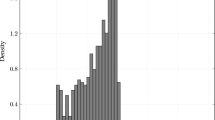Abstract.
The estimation of labor supply elasticities has been an important issue in the economic literature. Yet all works have estimated conditional mean labor supply functions only. The objective of this paper is to obtain more information on labor supply, estimating a conditional quantile labor supply function. We use a sample of prime age urban males employees in Brazil. Two stage estimators are used as the net wage and nonlabor income are found to be endogenous to the model. Contrary to previous works using conditional mean estimators, it is found that labor supply elasticities vary significantly and asymmetrically across hours of work. While the income and wage elasticities at the standard work week are zero, for those working longer hours the elasticities are negative.
Similar content being viewed by others
Author information
Authors and Affiliations
Rights and permissions
About this article
Cite this article
Pontual Ribeiro, E. Asymmetric labor supply. Empirical Economics 26, 183–197 (2001). https://doi.org/10.1007/s001810000060
Issue Date:
DOI: https://doi.org/10.1007/s001810000060




